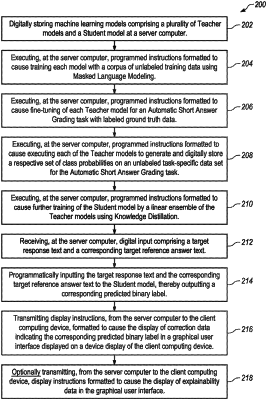| CPC G09B 7/04 (2013.01) [G06F 17/18 (2013.01); G06F 40/20 (2020.01); G06N 20/20 (2019.01)] | 20 Claims |

|
1. A computer-implemented method comprising:
digitally storing, in memory of a server computer, a plurality of machine learning models, the plurality of machine learning models comprising a plurality of Teacher models and a Student model, each of the machine learning models comprising a multi-layer bidirectional Transformer encoder and having been trained with at least one corpus of unlabeled training data using Masked Language Modeling;
updating, in the memory of the server computer, each Teacher model by further programmatically training that Teacher model to perform an Automatic Short Answer Grading task with a labeled ground truth data set, the labeled ground truth data set comprising a plurality of data triplets, each data triplet comprising a response text, a corresponding reference answer text, and a corresponding binary label;
executing each of the Teacher models to cause programmatically generating and storing, in the memory of the server computer, a respective set of class probabilities on an unlabeled task-specific data set for the Automatic Short Answer Grading task;
updating, in the memory of the server computer, the Student model by further programmatically training the Student model, with the unlabeled task-specific data set, to minimize an error between predictions of the Student model and predictions of a linear ensemble of the Teacher models;
receiving, at the server computer, digital input comprising a target response text and a corresponding target reference answer text;
programmatically inputting the target response text and the corresponding target reference answer text to the Student model, thereby outputting a corresponding predicted binary label;
causing to be displayed, in a graphical user interface displayed on a device display of a client computing device, correction data indicating the corresponding predicted binary label.
|